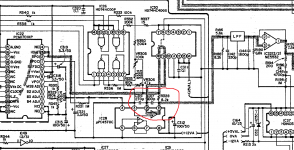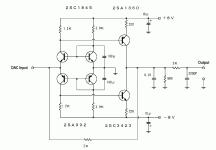Fet input , true, but not low capacitance fet input...actually lower speed fet input (audio op-amps)might be the way although any bipolar op-amp can be shunted at its input with a real capacitor with the same effect..Thank you to you 2
I initialy designed the board with AD8066 because of the jFET input stage said to be a better protection against RFI.
Moving to the AD812 from the AD8066 is easy enough to try.
I will definitly try to use a ferrite as suggested.
Jean
Attachments
Besides...if your upsampling is at 176khz you don't need high slew rate op-amps...you can go safely with opa1612 in the i/v converter too.
This is counter intuitive, can you explain why ?
Rs can be also in series with both RC which is a tiny bit better.You should go with opa1612 all the way, in both i/v and filters once you're upsampling .Adding those capacitors at the input like in Denon 1560 (you need to find the perfect values yourself) can be done with any op-amp.That circuit will work very well with any dac that outputs 1ma .In the AD797, the Rs is inside the feedback loop which I could do with the AD8066.
However, I don't see the interest in the AD812 as the Sallen Key filter begins with a 549 Ohm resistor.
And by the way...i tell this to anyone: before trying any fancy op-amp for i/v section, try first the old LM833 and UPC4570!!!
Higher sampling means less spurrious dac output, lower integrating capacitor , thus easier to drive too.This is counter intuitive, can you explain why ?
Abraxalito, from what you say, I shoud try the AD812 (cheap dual CFB similar to AD811).
I remain unconvinced that the AD812 is indeed very similar to AD811, I was under the impression that it was more like AD8017 but not quite as good. I tried AD8017 without filter, sounded desperately bright. But with a CLC filter its engaging without much hint of 'edge'.
I initialy designed the board with AD8066 because of the jFET input stage said to be a better protection against RFI.
I have also tried AD8065 (single version of 8066) and found it a bit bright. But I wondered whether that was more to do with the output stage than the FET input. I don't recall trying it without a filter.
A long time ago I tried some ADI parts with (I believe) non-LTP input stages. They were AD830s which are designed for high CMRR even to RF frequencies. I fed them balanced DAC outputs (passive I/V) and I was surprised they didn't turn out bright, even without filter.
I may also consider to replace the OPA1612 in the Sallen Key filter by an OTA buffer for better IMD although more noisy and with higher distorsion.
What do you think ?
Not sure. I have no experience with OPA1612 so don't know its strengths and weaknesses.
There's only one other circuit that rivals Technics class AA approach and that is described in great detail in the Art of electronics, third edition page 550...552, fig 8.87, fig 8.88.I am using both variations and they work best with any iout dac .Unfortunately i'm not sure i can post a pic from the book due to intellectual rights.
😉 : DIYHiFi.org • View topic - "Op-amps unsuitable for audio DAC I/V" - myth?
look for also Audial dac blog and topic as tech notes.
Also Johnc from Texas Instrument thread here at diya about 1656 oap.
look for also Audial dac blog and topic as tech notes.
Also Johnc from Texas Instrument thread here at diya about 1656 oap.
The I/V op amp used by TI in their evaluation kit for a 16 bits DAC is OPA277
Kit DAC8801/11EVM
DAC 8811U + OPA277U
I presume this the best I/V op amp for Texas Instruments engineers in some sense.
Recommendations from TI and AD insist about using precision amplifiers to ensure monotonicity of the DAC is preserved. The OPA277 precision is 10μV Vos.
Different sounding of DACs in DIYaudio, might come from no care about monotonicity of the digital to analog conversion.
What do you care of in dac and opa characteristics ?
Kit DAC8801/11EVM
DAC 8811U + OPA277U
I presume this the best I/V op amp for Texas Instruments engineers in some sense.
Recommendations from TI and AD insist about using precision amplifiers to ensure monotonicity of the DAC is preserved. The OPA277 precision is 10μV Vos.
Different sounding of DACs in DIYaudio, might come from no care about monotonicity of the digital to analog conversion.
What do you care of in dac and opa characteristics ?
Last edited:
first of all dac 8801 is 14 bit dac and made for ATE's which are rather slow at streaming data from analog...
I am talking about DAC8811 a 16 bits from TI.
Do not confuse from the name of the TI kit where appears 8801.
The kit is equipped with a DAC8811.
My question is not on the DAC itself, but on topic, on I/V op amps used with 16 bits DACs
Do not confuse from the name of the TI kit where appears 8801.
The kit is equipped with a DAC8811.
My question is not on the DAC itself, but on topic, on I/V op amps used with 16 bits DACs
the answer is : use a transconductance scheme without feedback aka opa861... tda1541a proof design is existing.
If transimpedance oaps uses, it also about the output impedance of the dac chips. Read the link for further details. opa1656, opa827, opa810, opa210, opa1612,opa1646, ada4627-1, ad797...
If transimpedance oaps uses, it also about the output impedance of the dac chips. Read the link for further details. opa1656, opa827, opa810, opa210, opa1612,opa1646, ada4627-1, ad797...
The monotonicity issue related to the offset voltage of the I/V opamp only applies to current output R2R DACs like AD5547. Plenty of popular audio DACs aren't based on this architecture - TDA1541, TDA1543, TDA1545, TDA1387 - so these DACs have a much wider choice of I/V opamps.
Is there an application note about TDA1541, TDA1543, TDA1545, TDA1387 or similar architecture DACs giving information about the I/V opamp.
Why not try a discrete opamp IV from Toshiyuki Beppu ?
(The 2k is the IV resistor.)
Very simple and low cost.
Most likely good sounding as well.
Transistors can still be found (KSC/KSA at Digikey, rest at Kessler).
But any low noise equivalent will also do.
Cheers,
Patrick
.
(The 2k is the IV resistor.)
Very simple and low cost.
Most likely good sounding as well.
Transistors can still be found (KSC/KSA at Digikey, rest at Kessler).
But any low noise equivalent will also do.
Cheers,
Patrick
.
Attachments
You can get dual transistors from Toshiba in SMD which are quite well matched.
Mostly within 1%, but you can always hand select.
Patrick
Mostly within 1%, but you can always hand select.
Patrick
Why not try a discrete opamp IV from Toshiyuki Beppu ?
(The 2k is the IV resistor.)
Very simple and low cost.
Most likely good sounding as well.
Transistors can still be found (KSC/KSA at Digikey, rest at Kessler).
But any low noise equivalent will also do.
Cheers,
Patrick
.
Hi Patrick,
I have your CEN or SEN, don't remember the one, think it's the bjt, I remember components were sorted out !
It seems for a technical reason I'm not able to understand, discrete designs are more suited than oaps for I/V of a dac... though perhaps needing a current mirror to work best. Have you please any idea about the reason please ?
Pedja Rogic published both a shematic with opa861 and a discrete diamond and said they will be very close if implemented properly...
What could be the bjt advantage of your Pass improvment design (iirc) over a discrete diamond or also a modern oap please ?
Also have some personal questioning about some curent dac output with a little ipedance as the 2K/3k AD1862 at 1 mA & 252 nS reasing time... which is maybe harder to work with than the tda1541A 😕
Anyway many thanks for the SEN/CEN shared.
Is there an application note about TDA1541, TDA1543, TDA1545, TDA1387 or similar architecture DACs giving information about the I/V opamp.
There was the famous tda1541 40 or 80 pages technical book for hifi brands... it was shared long time ago on forums. Unluckilly have not but am interrested as you if someone gently can provide it here 🙂
You can get dual transistors from Toshiba in SMD which are quite well matched.
Mostly within 1%, but you can always hand select.
Patrick
Again, they are not matched, because they are in different cases.
They are NN & PP match in SOT23-5.
I have measured thousands, so I know, for certain.
N-P hfe match you can easily do by a DMM and a test socket.
The only reason for proposing BJT is that most of you simply cannot get decent JFETs without paying a premium.
Mr. Rutgers has published an alternative circuit which does not use NFB separately.
https://www.by-rutgers.nl/Plaatjes/DACetc/DAC-Schemaas/Discr IVconverter.JPG
Cheers,
Patrick
I have measured thousands, so I know, for certain.
N-P hfe match you can easily do by a DMM and a test socket.
The only reason for proposing BJT is that most of you simply cannot get decent JFETs without paying a premium.
Mr. Rutgers has published an alternative circuit which does not use NFB separately.
https://www.by-rutgers.nl/Plaatjes/DACetc/DAC-Schemaas/Discr IVconverter.JPG
Cheers,
Patrick
Last edited:
- Home
- Source & Line
- Analog Line Level
- What's the best dual I/V opamp these days???

